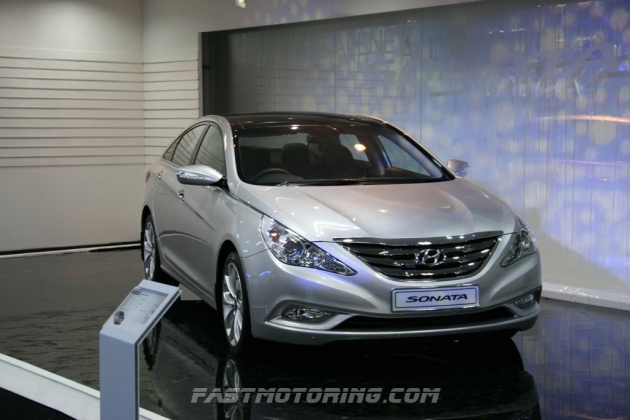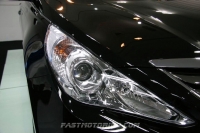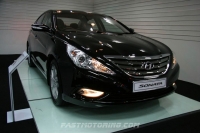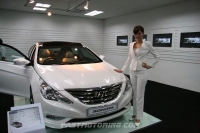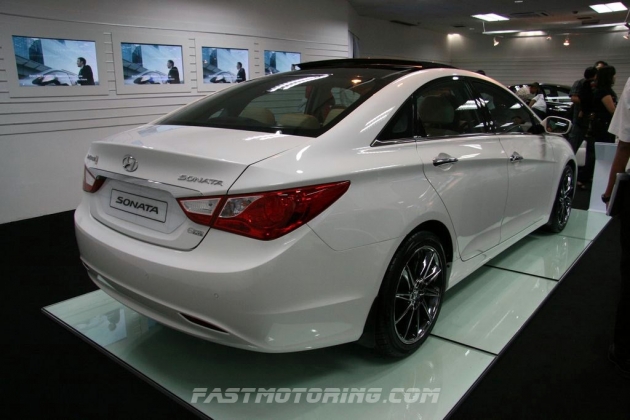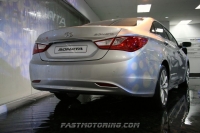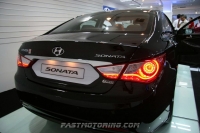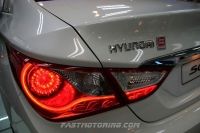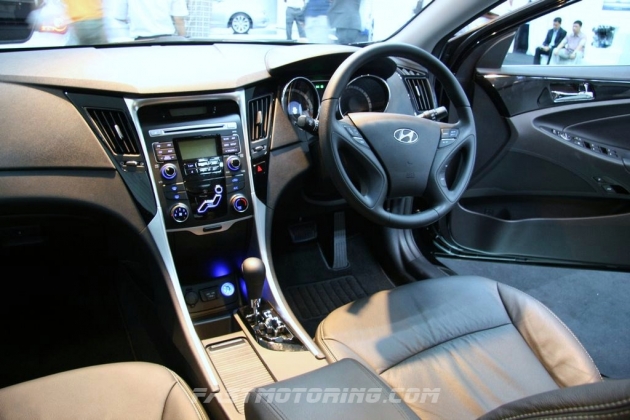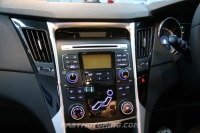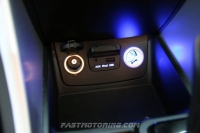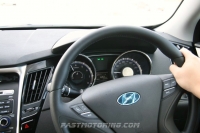
2002 BMW Z4 - Front Side
When the Z4 roadster was introduced a year ago, it was a significant leap forward from its highly successful Z3 predecessor. Indeed, the Z4′s debut was much more than just ‘successor replaces predecessor,’ for the new Z4 roadster put BMW in a more elevated, sophisticated segment of the roadster market. To paint the broad strokes: Built on a longer wheelbase than that of the Z3, the Z4 is also wider and longer – while employing advanced engineering to keep any associated weight increase to a minimum. More to the point, the Z4 expresses a traditional concept – that of the two-seat sport roadster – in utterly new terms of unique design, contemporary engineering and comprehensive features.
The Z4 places BMW squarely in the field of sophisticated, full-featured sport roadsters. It comes exclusively with 6-cylinder power and offers a choice of four transmission types. Its chassis engineering is new, encompassing multi-link rear suspension, standard run-flat tires and wheel/tire diameters up to 18 inches. The Z4 offers amenities and options never before seen in a regular-production BMW roadster. Safety engineering and features have been further developed.
As was the Z3, the Z4 Series is produced at BMW’s Spartanburg, South Carolina factory, which employs the most advanced production equipment and processes and serves all international markets for the Z4. Two models are offered: the Z4 roadster 2.5i at $33,895 base price including destination; and the higher-performing, more extensively equipped Z4 roadster 3.0i at $41,045. As with all other 2004 BMWs, these prices include BMW Full Maintenance for 4 years or 50,000 miles.
The BMW roadster tradition
As new as it is, the Z4 represents a long-standing BMW tradition. The Bavarian automaker’s roadster lineage begins in 1935 with the 315/1 and 319/1, two versions of an energetic little two-seater powered by engines that were small, yet had 6 cylinders. (Even then, engine smoothness and sound were BMW priorities.) In 1936, the tradition became a legend with the 328 roadster, which began as a successful racing car, went on to become a beloved sports car, and finally became one of the great collectibles of its era.
Another great BMW classic was the 507, of which only about 250 were built in the mid- to late 1950s. Today, this stunningly designed, V8-powered roadster commands high six-figure prices at collector-car auctions. Elvis Presley owned one while stationed in Germany with the U.S. military.
Virtually unknown in America, yet also important to BMW’s roadster lineage, was the Z1 – conceptually amazing, with a fiberglass body and electrically retracting doors. The Z1 was expensive, built in small numbers, and offered only overseas.
In 1996, BMW introduced a roadster that would be accessible to many more customers: the Z3. Designed and engineered to be produced at moderate prices, the Z3 was an instant, international hit. Over its seven-year production span, it evolved from a single 4-cylinder model to a line of 6-cylinder roadsters and a coupe. It will be remembered as a relatively simple, elemental, fun-to-drive machine of typically high BMW quality and unique style.
With its design inspired by the classic 507, the Z8 made its debut in 2000 as BMW’s highest-performing, highest-technology roadster. It continues through 2003, completing a limited production run and commanding the respect of those who test-drove for the media and those with the means to own it. No one at BMW would be surprised if the Z8, like so many of the BMW roadsters before it, becomes a significant collector automobile.
The Z4 not only takes its place in this illustrious historical line, but brings the design and technology of the more popular-priced BMW roadster to a level that, in many ways, is comparable with what the limited-production Z8 offers.
Aerodynamics: Outstanding for an open-bodied vehicle
It is far more challenging to achieve efficient aerodynamics with an open-body car than with a closed one; yet BMW’s designers and aerodynamicists achieved major progress. With its softtop in place, the Z4 has an aerodynamic drag coefficient (CD ) of just 0.35. And extensive development has minimized drafts around the faces and upper bodies of Z4 occupants when the top is down: In its May ’03 issue, Road & Track reported that ‘at a constant 75 mph with the side windows down, we found the wind only tugging lightly at our cars.’
Smooth, powerful 6-cylinder engines
In a sea of V-6 engines, BMW swims almost solo with its unusual – but in BMW’s opinion superior – inline-6 configuration. The Z4 roadsters are powered by two versions of the M54 6-cylinder engine family; of the 3.0-liter version powering the Z4 3.0i, Automobile Magazine (August ’03) wrote that ‘Its torquey, 3.0-liter six is always ready to respond.’
In addition to its inline six cylinders, this brilliant engine architecture features:
• Aluminum construction, contributing to vehicle performance by keeping down engine weight.
• Dual overhead camshafts and four valves per cylinder, for optimum torque and power.
• Chain camshaft drive, requiring no periodic replacement.
• Double VANOS steplessly variable valve timing, enhancing torque, power and emission control.
• Hydraulic valve adjustment for consistent sound and reduced maintenance.
• Electronic throttle system (‘drive by wire’) for smooth, precisely tuned throttle action and seamless integration of cruise control, Dynamic Stability Control and other features. This also facilitates an appealing option: Dynamic Driving Control, about which more later.
• Electronically controlled engine cooling, enabling precise and purposeful control of engine temperatures; contributes to fuel efficiency and heater effectiveness.
With all these elements of engine architecture shared, two versions of this powerplant power the two Z4 models:
Z4 2.5i. 2.5-liter, with 184 horsepower and 175 lb.-ft. of torque. This unit delivers 0 to 60 mph in 7.1 sec. (manual trans., BMW AG test results) and achieves the amazing top speed of 146 mph. Its EPA mileage ratings are impressive too: 20 mpg city/28 mpg highway with 5-speed manual transmission, 20/29 with the optional 6-speed Sequential Manual Gearbox (SMG), and fully 21/28 with the available 5-speed automatic. Top speed is 137 mph with the 5-speed, 146 with SMG and 141 with the automatic.
Z4 3.0i. 3.0-liter, with 225 hp and 214 lb-ft. of torque. This version is further refined for an even more exciting sound. Motor Trend noted in its May ’03 issue that ‘It delivers an impressive amount of power, with vibration evident only by its absence…Underway, dual exhaust tips broadcast a turbine-like mechanical growl that’s wired directly to the driver’s right foot.’ This engine powers the Z4 3.0i to 60 mph in just 5.9 sec. with the standard 6-speed manual transmission or optional SMG, and reaches 60 mph in only a tick more at 6.0 sec. with automatic (BMW AG test results). Top speed is electronically limited to 155 mph with the manual transmission or SMG; with the automatic it is a ‘natural’ 152 mph. With its manual transmission, the Z4 3.0i earns excellent EPA mileage ratings of 21 mpg city / 29 mpg highway; with SMG the ratings are 20/29 and with automatic 19/27.
5- and 6-speed manual transmissions
While the 2.5i model’s standard transmission is a 5-speed manual, standard in the 3.0i is a 6-speed unit. Weighing no more than the 5-speed, this ‘gearbox’ incorporates refinements for even greater driving pleasure (and BMWs are already known for excellent manual transmissions):
• Even more effective synchronization of shifting
• Sportier shifting, via a 20-mm (0.8-in.) shorter shift lever and 10-mm (0.4-in) shorter shift ‘throws’ from neutral to each gear.
Optional STEPTRONIC 5-speed automatic transmission
Available for both models is the 5-speed STEPTRONIC unit that has garnered repeated praise from auto critics. Like all other current BMW automatics, it incorporates –
• A Sport mode that programs automatic shifts at higher engine speeds
• A Manual mode, which lets the driver choose shifts manually by ‘flicking’ the lever rearward or forward. Though basically similar to the transmission offered in other BMW 6-cylinder models, it is specially tailored to the Z4 with a ‘tighter’ torque converter (thus a more direct response feel) and specific shift characteristics.
‘Third way’: The Sequential Manual Gearbox
BMW currently offers two types of Sequential Manual Gearbox (SMG), both of which apply electrohydraulically actuated, electronically or driver-controlled shifting to a 6-speed manual transmission. Available on the super-performance M3 models is the very elaborate DRIVELOGIC version, which offers drivers a total of 11 shift programs. The version offered as optional equipment for Z4 roadsters (and, for ’04, the 3 and 5 Series as well) is engineered for performance, convenience and (above all) driving pleasure; it offers a total of four shift programs:
• In its Automated mode, labeled D, a Normal program, and a Sport mode that executes shifts at higher engine speeds and makes the shifts themselves quicker.
• In its Manual mode, also a Normal and a Sport program; here the Sport program makes the shifts quicker, but the driver determines when the shifts occur.
In either mode, the Sport program is selected via a button on the console.
There is no clutch pedal. The driver selects the desired operating range (N, R, D, S = Sequential) with a console-mounted selector lever, and can execute manual shifts with that lever or with two ‘paddles’ on the steering wheel. After starting the engine (which requires putting the lever in N and applying the brake pedal), the driver moves the lever to the right; this selects the Sequential mode, in which each tap of the lever or paddle(s) shifts the transmission up or down one gear. Moving the lever to the right toggles the unit to its Drive mode, in which shifts occur without the driver’s intervention. To revert to Sequential shifting, the driver can toggle the lever to the right again (and simply tap it toward ‘+’ for an upshift or ‘–’ for a downshift) or toggle one of the steering-wheel-mounted shift paddles. By pulling either steering wheel-mounted paddle, an upshift is executed. Pushing either paddle with your thumb produces a smooth downshift.
In either the Drive or the Sequential mode, an instrument-cluster display indicates the gear currently engaged. In Drive, a ‘D’ is displayed next to the gear. When the Sport program is activated, an orange indicator light next to the Sport button illuminates.
Though SMG does offer automated shifting, it is not meant to serve as a conventional automatic transmission; that role is played by the also available STEPTRONIC automatic. Just as with a manual transmission, power is interrupted for shifts – though in hard, performance-oriented driving the shifts can be stunningly quick. SMG’s appeal lies in these considerations:
• It is a racing technology, pioneered in Formula 1 competition and predominant in that sport today.
• It offers a new kind of actively enjoyable driving, and fascinating new things for an enthusiastic driver to learn.
• Relative to a manual transmission, it entails no performance loss and minimal increase in fuel consumption. In fact, it can match or even exceed the performance achieved by an expert driver.
Z4 running gear: This roadster is glued to the road
The Z4 raises enthusiasts’ expectations of how a sports car should handle. Starting with a brand-new body/chassis structure, BMW chassis engineers developed a sports-car platform that is almost literally glued to the road. The basis for this remarkable platform is a body/chassis structure with exceptional stiffness for a roadster; it achieves 21 Hertz – truly outstanding for a roadster, and close to the 25-26 Hz of today’s BMW sedans. A number of specific features contribute to this rigidity:
• Y-form front longitudinal members. Each chassis rail carrying the engine (one per side) branches into a ‘Y’ to form a side sill and half of the central tunnel. In this regard, the Z4 is similar to the Z8 roadster (though the Z8 structure is of aluminum, the Z4′s of steel).
• The side sills are configured to achieve maximum rigidity within acceptable bulk. (It’s not acceptable simply to make them huge; this would cut into passenger space or make the car too bulky.)
• The underbody (floor pan) is designed to spread its strength evenly over its entire length and width.
• The underbody is further reinforced by two thrust plates, similar to those employed in the M3 models. The front one is of aluminum, the rear of steel. Also as in M3s, there are reinforcing braces from the front suspension’s strut towers to the cowl area.
• High-strength steels are employed extensively for best strength without excess weight.
• To save additional weight, the hood is of aluminum.
In general terms, the Z4 suspension system applies concepts familiar from the 3 Series. Now, imagine a further developed system in vehicles almost 300 pounds lighter and with a significantly lower center of gravity, and you get an idea of the Z4′s potential. Here are the particulars:
Strut-type front suspension. with notable features:
• Forged aluminum lower arms, to reduce unsprung weight and thus improve ride and handling on rough road surfaces.
• Hollow strut rods, vs. solid; these weight 10% less than conventional solid rods.
• Relatively large positive caster to improve straight-line stability.
• Wide track – 58.0 in.
Central Link rear suspension, a multi-link concept. The Central Link from which the system derives its name is a large, curved longitudinal arm, pivoted directly ahead of the rear wheel’s vertical and horizontal centerpoint on a large rubber bushing of highly sophisticated design. Each wheel also has an upper and a lower lateral arm, for a total of three links per wheel. The system contributes to remarkable handling and riding comfort, yet is simpler than many multi-link concepts. Salient features include:
• Wide track, 60.0 in.
• Relatively large negative camber angles. Z4s have 2.25° negative camber at rest, visible in a slight inward tilt of the tops of the rear tires.
• Extra-firm forward bushings for the subframe that carries the suspension system.
• Aluminum upper transverse links to help reduce unsprung weight.
Overall suspension calibration. To underscore the Z4′s sporting nature, relatively firm springs, shock absorbers and anti-roll (stabilizer) bars have been adapted. This means a firm ride and very ‘flat’ cornering.
Because the standard suspension calibration is inherently sporty and the standard run-flat performance tires are relatively stiff, the available sport suspension (included in each model’s Sport Package) does not employ firmer springs, shock absorbers and anti-roll bars as is customary with BMW sport suspension. Instead, its only difference is a 15-mm (0.6-in.) lower ride height.
Every Sport Package-equipped Z4 comes with Dynamic Driving Control, which provides a Sport button on the console that selects –
• Firmer steering effort (less power assist) via the electric power steering
• Quicker accelerator response via the ‘drive by wire’ throttle system
• In vehicles with automatic transmission, an additional Sport mode beyond that selected with the shift lever.
Electric power steering: innovation with significant benefits
The Z4 incorporates an electric power steering system: the steering is assisted by an electric servo motor rather than the conventional hydraulic pump. Among the benefits of this feature are:
• Facilitates specific tuning of steering to the vehicle – shock damping, on-center feel, return to center position, overall steering feel – via software.
• Vehicle-speed-sensitive power assist (Servotronic).
• Reduced vehicle fuel consumption, because the electric motor operates only when the steering wheel is turned.
The servo motor applies its assist to the upper portion of the steering column; its control electronics are in a housing mounted directly to the motor.
Generously dimensioned brakes
The Z4 3.0i gets ventilated rear discs, and both models have larger-diameter rear discs than those of their Z3 predecessor. Equipment is as follows:
• 2.5i – Ventilated front discs of 286-mm/11.3-in. diameter; solid rear discs of 280-mm/11.0-in. diameter.
• 3.0i – Ventilated front discs of 300-mm/11.8-in. diameter; ventilated rear discs of 294-mm/11.6-in. diameter.
BMW has applied two refinements to the handbrake mechanism. One is a self-adjusting actuating cable, reducing the need for periodic adjustment; the other is a newly designed cable linkage that ensures equal handbrake force on both rear wheels.
Run-flat tires, standard
Every Z4 comes standard with BMW’s Run-Flat Combination (RFC), an important step forward in personal safety, convenience and in-vehicle space utilization.
The system consists of self-supporting tires, special wheel rims and a Flat Tire Monitor. The tires have special sidewalls that include specific inserts and highly heat-resistant rubber compounds. These features allow a deflated tire to maintain its essential shape and guidance characteristics for a considerable distance.
While maintaining the handling and safety standards of high-performance tires, the RFC system offers these advantages:
No roadside tire changes. It will be seldom, if ever, necessary to stop and change a damaged tire. When confronted with a flat (a condition revealed to the driver by the Flat Tire Monitor), the driver can continue on for up to 90 miles at speeds up to 50 mph until reaching a safe and/or convenient place to have the tire repaired or replaced.
Tire stays on rim, thanks to specially developed wheel rims.
Stability systems remain functional. All Dynamic Stability Control functions remain fully in effect, even with a deflated tire.
Increased trunk space. With RFC, no spare is needed, so the trunk can be larger.
Weight savings. The weight of a spare tire is eliminated
Price this car:
MSRP:
not available yet
Invoice:
not available yet
Source: BMW Press Release
Prices, Reviews, and Specifications by
DistroCars.com.
Gallery of 2002 BMW Z4 Sport Roadsters with 6 Cylinder Engines
